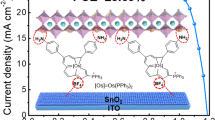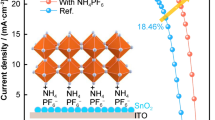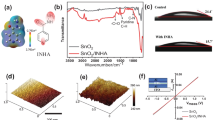Abstract
Trap-mediated energy loss in the buried interface with non-exposed feature constitutes one of the serious challenges for achieving high-performance perovskite solar cells (PSCs). Inspired by the adhesion mechanism of mussels, herein, three catechol derivatives with functional Lewis base groups, namely 3,4-Dihydroxyphenylalanine (DOPA), 3,4-Dihydroxyphenethylamine (DA) and 3-(3,4-Dihydroxyphenyl) propionic acid (DPPA), were strategically designed. These molecules as interfacial linkers are incorporated into the buried interface between perovskite and SnO2 surface, achieving bilateral synergetic passivation effect. The crosslinking can produce secondary bonding with the undercoordinated Pb2+ and Sn4+ exhibited the best performance and operational stability. Upon the DOPA passivation, a stabilized power conversion efficiency (PCE) of 21.5% was demonstrated for the planar PSCs. After 55 days of room-temperature storage, the unencapsulated devices with the DOPA crosslinker could still maintain 85% of their initial performance in air under relative humidity of ≈15%. This work opens up a new strategy for passivating the buried interfaces of perovskite photovoltaics and also provides important insights into designing defect passivation agents for other perovskite optoelectronic devices, such as light-emitting diodes, photodetectors, and lasers.

Similar content being viewed by others
References
Liu, S.; Guan, Y. J.; Sheng, Y. S.; Hu, Y.; Rong, Y. G.; Mei, A. Y.; Han, H. W. A review on additives for halide perovskite solar cells. Adv. Energy Mater. 2020, 10, 1902492.
Kim, J. Y.; Lee, J. W.; Jung, H. S.; Shin, H.; Park, N. G. High-efficiency perovskite solar cells. Chem. Rev. 2020, 120, 7867–7918.
Golden. National Renewable Energy Laboratory Best Research-Cell Efficiency Chart [Online]. https://www.nrel.gov/pv/assets/pdfs/best-research-cell-efficiencies.20200311.pdf. (2020-5-1)
Fu, L.; Li, H.; Wang, L.; Yin, R. Y.; Li, B.; Yin, L. W. Defect passivation strategies in perovskites for an enhanced photovoltaic performance. Energy Environ. Sci. 2020, 13, 4017–4056.
Vasilopoulou, M.; Fakharuddin, A.; Coutsolelos, A. G.; Falaras, P.; Argitis, P.; Yusoff, A. R. B. M.; Nazeeruddin, M. K. Molecular materials as interfacial layers and additives in perovskite solar cells. Chem. Soc. Rev. 2020, 49, 4496–4526.
Cai, F. L.; Yan, Y.; Yao, J. X.; Wang, P.; Wang, H.; Gurney, R. S.; Liu, D.; Wang, T. Ionic additive engineering toward high-efficiency perovskite solar cells with reduced grain boundaries and trap density. Adv. Funct. Mater. 2018, 28, 1801985.
Liu, X. X.; Yu, Z. G.; Wang, T.; Chiu, K. L.; Lin, F.; Gong, H.; Ding, L. M.; Cheng, Y. H. Full defects passivation enables 21% efficiency perovskite solar cells operating in air. Adv. Energy Mater. 2020, 10, 2001958.
Wu, Z. F.; Jiang, M. W.; Liu, Z. H.; Jamshaid, A.; Ono, L. K.; Qi, Y. B. Highly efficient perovskite solar cells enabled by multiple ligand passivation. Adv. Energy Mater. 2020, 10, 1903696.
Yang, X. Y.; Luo, D. Y.; Xiang, Y. R.; Zhao, L. C.; Anaya, M.; Shen, Y. L.; Wu, J.; Yang, W. Q.; Chiang, Y. H.; Tu, Y. G. et al. Buried interfaces in halide perovskite photovoltaics. Adv. Mater. 2021, 33, 2006435.
Xiao, M. Y.; Lu, T. Y.; Lin, T.; Andre, J. S.; Chen, Z. Understanding molecular structures of buried interfaces in halide perovskite photovoltaic devices nondestructively with sub-monolayer sensitivity using sum frequency generation vibrational spectroscopy. Adv. Energy Mater. 2020, 10, 1903053.
Xiao, M. Y.; Joglekar, S.; Zhang, X. X.; Jasensky, J.; Ma, J. L.; Cui, Q. Y.; Guo, L. J.; Chen, Z. Effect of interfacial molecular orientation on power conversion efficiency of perovskite solar cells. J. Am. Chem. Soc. 2017, 139, 3378–3386.
Liu, Z. Z.; Deng, K. M.; Hu, J.; Li, L. Coagulated SnO2 colloids for high-performance planar perovskite solar cells with negligible hysteresis and improved stability. Angew. Chem., Int. Ed. 2019, 58, 11497–11504.
Xiong, L. B.; Guo, Y. X.; Wen, J.; Liu, H. R.; Yang, G.; Qin, P. L.; Fang, G. J. Review on the application of SnO2 in perovskite solar cells. Adv. Funct. Mater. 2018, 28, 1802757.
Jiang, Q.; Zhang, X. W.; You, J. B. SnO2: A wonderful electron transport layer for perovskite solar cells. Small 2018, 14, 1801154.
Zhang, S. C.; Si, H. N.; Fan, W. Q.; Shi, M. Y.; Li, M. H.; Xu, C. Z.; Zhang, Z.; Liao, Q. L.; Sattar, A.; Kang, Z.; Zhang, Y. Graphdiyne: Bridging SnO2 and perovskite in planar solar cells. Angew. Chem., Int. Ed. 2020, 59, 11573–11582.
Lee, H. B.; Kumar, N.; Ovhal, M. M.; Kim, Y. J.; Song, Y. M.; Kang, J. W. Dopant-free, amorphous-crystalline heterophase SnO2 electron transport bilayer enables >20% efficiency in triple-cation perovskite solar cells. Adv. Funct. Mater. 2020, 30, 2001559.
You, S.; Zeng, H. P.; Ku, Z. L.; Wang, X. Z.; Wang, Z.; Rong, Y. G.; Zhao, Y.; Zheng, X.; Luo, L.; Li, L. et al. Multifunctional polymerregulated SnO2 nanocrystals enhance interface contact for efficient and stable planar perovskite solar cells. Adv. Mater. 2020, 32, 2003990.
Wang, J. K.; Datta, K.; Weijtens, C. H. L.; Wienk, M. M.; Janssen, R. A. J. Insights into fullerene passivation of SnO2 electron transport layers in perovskite solar cells. Adv. Funct. Mater. 2019, 29, 1905883.
Liu, K.; Chen, S.; Wu, J. H.; Zhang, H. Y.; Qin, M. C.; Lu, X. H.; Tu, Y. F.; Meng, Q. B.; Zhan, X. W. Fullerene derivative anchored SnO2 for high-performance perovskite solar cells. Energy Environ. Sci. 2018, 11, 3463–3471.
Yang, D.; Yang, R. X.; Wang, K.; Wu, C. C.; Zhu, X. J.; Feng, J. S.; Ren, X. D.; Fang, G. J.; Priya, S.; Liu, S. High efficiency planar-type perovskite solar cells with negligible hysteresis using EDTA-complexed SnO2. Nat. Commun. 2018, 9, 3239.
Chen, B.; Rudd, P. N.; Yang, S.; Yuan, Y. B.; Huang, J. S. Imperfections and their passivation in halide perovskite solar cells. Chem. Soc. Rev. 2019, 48, 3842–3867.
Xue, Q. F.; Liu, M. Y.; Li, Z. C.; Yan, L.; Hu, Z. C.; Zhou, J. W.; Li, W. Q.; Jiang, X. F.; Xu, B. M.; Huang, F. et al. Efficient and stable perovskite solar cells via dual functionalization of dopamine semiquinone radical with improved trap passivation capabilities. Adv. Funct. Mater. 2018, 28, 1707444.
Wang, F.; Geng, W.; Zhou, Y.; Fang, H. H.; Tong, C. J.; Loi, M. A.; Liu, L. M.; Zhao, N. Phenylalkylamine passivation of organolead halide perovskites enabling high-efficiency and air-stable photovoltaic cells. Adv. Mater. 2016, 28, 9986–9992.
Zhang, Y. Q.; Liu, X. T.; Li, P. W.; Duan, Y. Y.; Hu, X. T.; Li, F. Y.; Song, Y. L. Dopamine-crosslinked TiO2/perovskite layer for efficient and photostable perovskite solar cells under full spectral continuous illumination. Nano Energy 2019, 56, 733–740.
Long, X. L.; Xu, H. L.; Zhang, D. Y.; Li, J. S. Bioinspired by both mussel foot protein and bone sialoprotein: Universal adhesive coatings for the promotion of mineralization and osteogenic differentiation. Polym. Chem. 2020, 11, 4995–5004.
Wei, W.; Petrone, L.; Tan, Y.; Cai, H.; Israelachvili, J. N.; Miserez, A.; Waite, J. H. An underwater surface-drying peptide inspired by a mussel adhesive protein. Adv. Funct. Mater. 2016, 26, 3496–3507.
Yang, B.; Jin, S.; Park, Y.; Jung, Y. M.; Cha, H. J. Coacervation of interfacial adhesive proteins for initial mussel adhesion to a wet surface. Small 2018, 14, 1803377.
Yang, B.; Lim, C.; Hwang, D. S.; Cha, H. J. Switch of surface adhesion to cohesion by DOPA-Fe3+ complexation, in response to microenvironment at the mussel plaque/substrate interface. Chem. Mater. 2016, 28, 7982–7989.
Wang, J.; Zhang, J.; Zhou, Y. Z.; Liu, H. B.; Xue, Q. F.; Li, X. S.; Chueh, C. C.; Yip, H. L.; Zhu, Z. L.; Jen, A. K. Y. Highly efficient all-inorganic perovskite solar cells with suppressed non-radiative recombination by a Lewis base. Nat. Commun. 2020, 11, 177.
Batzill, M.; Diebold, U. The surface and materials science of tin oxide. Prog. Surf. Sci. 2005, 79, 47–154.
Chen, Y.; Zuo, X. J.; He, Y. Y.; Qian, F.; Zuo, S. N.; Zhang, Y. L.; Liang, L.; Chen, Z. Q.; Zhao, K.; Liu, Z. K. et al. Dual passivation of perovskite and SnO2 for high-efficiency MAPbI3 perovskite solar cells. Adv. Sci. 2021, 8, 2001466.
Cai, Y.; Cui, J.; Chen, M.; Zhang, M. M.; Han, Y.; Qian, F.; Zhao, H.; Yang, S. M.; Yang, Z.; Bian, H. T. et al. Multifunctional enhancement for highly stable and efficient perovskite solar cells. Adv. Funct. Mater. 2020, 31, 2005776.
Wu, W. Q.; Yang, Z. B.; Rudd, P. N.; Shao, Y. C.; Dai, X. Z.; Wei, H. T.; Zhao, J. J.; Fang, Y. J.; Wang, Q.; Liu, Y. et al. Bilateral alkylamine for suppressing charge recombination and improving stability in blade-coated perovskite solar cells. Sci. Adv. 2019, 5, eaav8925.
Wang, R.; Xue, J. J.; Wang, K. L.; Wang, Z. K.; Luo, Y. Q.; Fenning D.; Xu, G. W.; Nuryyeva, S.; Huang, T. Y.; Zhao, Y. P. et al. Constructive molecular configurations for surface-defect passivation of perovskite photovoltaics. Science 2019, 366, 1509–1513.
Zhao, Y. P.; Zhu, P. C.; Huang, S.; Tan, S.; Wang, M. H.; Wang, R.; Xue, J. J.; Han, T. H.; Lee, S. J.; Zhang, A. N. et al. Molecular interaction regulates the performance and longevity of defect passivation for metal halide perovskite solar cells. J. Am. Chem. Soc. 2020, 142, 20071–20079.
Tu, B.; Shao, Y. F.; Chen, W.; Wu, Y. H.; Li, X.; He, Y. L.; Li, J. X.; Liu, F. Z.; Zhang, Z.; Lin, Y.; Lan, X. Q. et al. Novel molecular doping mechanism for n-doping of SnO2 via triphenylphosphine oxide and its effect on perovskite solar cells. Adv. Mater. 2019, 31, 1805944.
Jung, E. H.; Chen, B.; Bertens, K.; Vafaie, M.; Teale, S.; Proppe, A.; Hou, Y.; Zhu, T.; Zheng, C.; Sargent, E. H. Bifunctional surface engineering on SnO2 reduces energy loss in perovskite solar cells. ACS Energy Lett. 2020, 5, 2796–2801.
Obrzut, J.; Page, K. A. Electrical conductivity and relaxation in poly(3-hexylthiophene). Phys. Rev. B 2009, 80, 195211.
Goodman, A. M.; Rose, A. Double extraction of uniformly generated electron-hole pairs from insulators with noninjecting contacts. J. Appl. Phys. 1971, 42, 2823–2830.
Jung, M.; Ji, S. G.; Kim, G.; Seok, S. I. Perovskite precursor solution chemistry: From fundamentals to photovoltaic applications. Chem. Soc. Rev. 2019, 48, 2011–2038.
Bi, C.; Wang, Q.; Shao, Y. C.; Yuan, Y. B.; Xiao, Z. G.; Huang J. S. Nonwetting surface-driven high-aspect-ratio crystalline grain growth for efficient hybrid perovskite solar cells. Nat. Commun. 2015, 6, 7747.
Shi, D.; Adinolfi, V.; Comin, R.; Yuan, M. J.; Alarousu, E.; Buin, A.; Chen, Y.; Hoogland, S.; Rothenberger, A.; Katsiev, K. et al. Low trap-state density and long carrier diffusion in organolead trihalide perovskite single crystals. Science 2015, 347, 519–522.
Min, H.; Kim, M.; Lee, S. U.; Kim, H.; Kim, G.; Choi, K.; Lee, J. H.; Seok, S. I. Efficient, stable solar cells by using inherent bandgap of α-phase formamidinium lead iodide. Science 2019, 366, 749–753.
Motti, S. G.; Meggiolaro, D.; Martani, S.; Sorrentino, R.; Barker, A. J.; De Angelis, F.; Petrozza, A. Defect activity in lead halide perovskites. Adv. Mater. 2019, 31, 1901183.
Zhang, X. L.; Santra, P. K.; Tian, L.; Johansson, M. B.; Rensmo, H.; Johansson, E. M. J. Highly efficient flexible quantum dot solar cells with improved electron extraction using MgZnO nanocrystals. ACS Nano 2017, 11, 8478–8487.
Kirchartz, T.; Deledalle, F.; Tuladhar, P. S.; Durrant, J. R.; Nelson, J. On the differences between dark and light ideality factor in polymer: Fullerene solar cells. J. Phys. Chem. Lett. 2013, 4, 2371–2376.
Bai, S.; Da, P. M.; Li, C.; Wang, Z. P.; Yuan, Z. C.; Fu, F.; Kawecki, M.; Liu, X. J.; Sakai, N.; Wang, J. T. W. et al. Planar perovskite solar cells with long-term stability using ionic liquid additives. Nature 2019, 571, 245–250.
Kresse, G.; Joubert, D. From ultrasoft pseudopotentials to the Projector Augmented-Wave method. Phys. Rev. B 1999, 59, 1758–1775.
Perdew, J. P.; Burke, K.; Ernzerhof, M. Generalized gradient approximation made simple. Phys. Rev. Lett. 1996, 77, 3865–3868.
Grimme, S.; Antony, J.; Ehrlich, S.; Krieg, H. A consistent and accurate ab initio parametrization of density functional dispersion correction (DFT-D) for the 94 elements H-Pu. J. Chem. Phys. 2010, 132, 154104.
Acknowledgements
The authors thank the financial support from the National Key R&D Program of China (No. 2018YFA0208501), the National Nature Science Foundation of China (Nos. 51803217, 51773206, 91963212, and 51961145102 [BRICS project]), Beijing National Laboratory for Molecular Sciences (Nos. BNLMS-CXXM-202005 and 2019BMS20003), K. C. Wong Education Foundation, Beijing National Laboratory for Molecular Sciences (BNLMS-CXXM-202005), Key R&D and Promotion Project of Henan Province (No. 192102210032), Open Project of State Key Laboratory of Silicon Materials (No. SKL2019-10), and Outstanding Young Talent Research Fund of Zhengzhou University. The authors also thank the Advanced Analysis & Computation Center at Zhengzhou University for materials and device characterization support. The authors also thank Prof. Bin Zhang in School of Materials Science and Engineering at Zhengzhou University for the materials characterization and analysis.
Author information
Authors and Affiliations
Corresponding author
Electronic Supplementary Material
12274_2021_3600_MOESM1_ESM.pdf
Bioinspired molecules design for bilateral synergistic passivation in buried interfaces of planar perovskite solar cells
Rights and permissions
About this article
Cite this article
Wang, B., Ma, J., Li, Z. et al. Bioinspired molecules design for bilateral synergistic passivation in buried interfaces of planar perovskite solar cells. Nano Res. 15, 1069–1078 (2022). https://doi.org/10.1007/s12274-021-3600-z
Received:
Revised:
Accepted:
Published:
Issue Date:
DOI: https://doi.org/10.1007/s12274-021-3600-z




